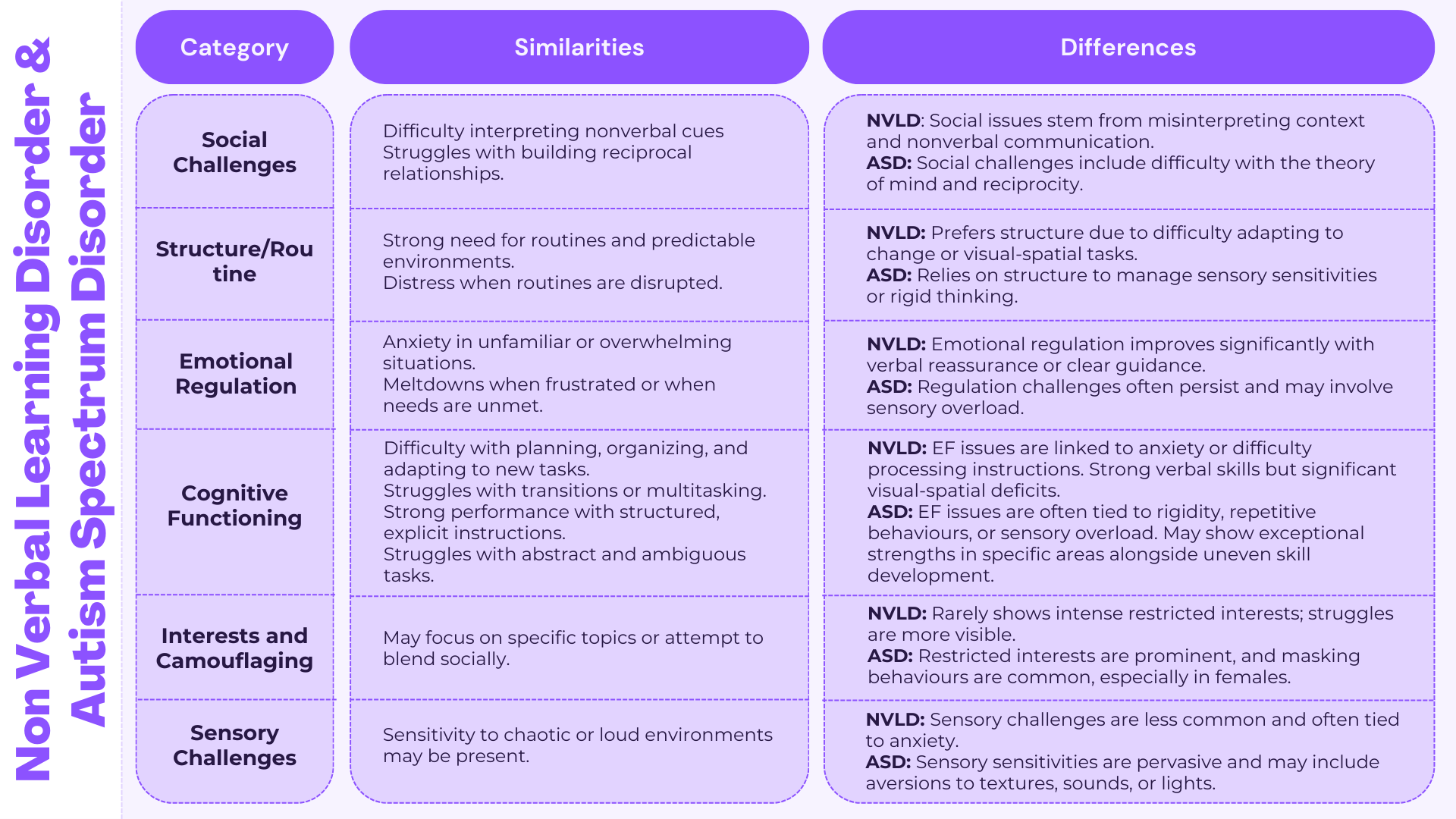NVLD and ASD
Nonverbal Learning Disorder (NVLD) and Autism Spectrum Disorder (ASD)
Understanding the Differences and Similarities
Nonverbal Learning Disorder (NVLD) and Autism Spectrum Disorder (ASD) share several overlapping characteristics, making differentiation challenging. Both conditions can impact social interactions, executive functioning, and emotional regulation. However, they have distinct cognitive profiles and underlying causes. This article will explore the similarities and differences between NVLD and ASD, helping clarify diagnostic distinctions and support strategies.
What is NVLD?
NVLD is a learning disorder characterized by significant deficits in visual-spatial processing, motor coordination, and nonverbal communication, despite strong verbal abilities. Individuals with NVLD struggle with interpreting facial expressions, body language, and abstract concepts, which can impact their social interactions. However, their verbal communication skills often remain intact or even above average.
What is ASD?
ASD is a neurodevelopmental condition affecting social communication, behavior, and sensory processing. It is a spectrum disorder, meaning symptoms can vary widely in severity. Individuals with ASD may experience difficulties with social reciprocity, restricted interests, sensory sensitivities, and repetitive behaviors. While some autistic individuals excel in certain cognitive areas, others may have uneven skill development.
Key Similarities and Differences (Table)
How Visual-Spatial Challenges Manifest in NVLD
One of the key distinguishing features of NVLD is significant difficulty with visual-spatial reasoning. This can affect a variety of everyday tasks, such as:
Struggling to read maps or follow directions.
Poor hand-eye coordination, impacting activities like sports or handwriting.
Trouble interpreting graphs, charts, or visual instructions.
Issues with spatial organization, leading to messy workspaces or difficulty with puzzles.
These challenges can make academic subjects like geometry particularly difficult, despite strengths in verbal-based subjects like reading and writing.
Self-Regulation and the Need for Structure
Both individuals with NVLD and ASD may struggle with self-regulation, but for different reasons. Children with NVLD may have meltdowns when they are late for school due to heightened anxiety and difficulty adapting to change. They may rely heavily on verbal reasoning to manage their emotions and need clear, structured guidance. In contrast, those with ASD might experience distress from disrupted routines due to an innate need for sameness and predictability.
Misconceptions About Autism in Females and NVLD Confusion
Recent research on autism, particularly in females, has challenged outdated stereotypes. Many autistic females display strong social motivation and empathy, but still struggle with underlying social communication difficulties. This has led to frequent misdiagnosis, with some autistic females being mistakenly identified as having NVLD or anxiety disorders instead. The presence of strong verbal abilities does not exclude an autism diagnosis, as many autistic individuals—especially females—use verbal intelligence to compensate for social deficits.
Ensuring the Right Diagnosis
A comprehensive evaluation by a neuropsychologist or developmental specialist is crucial in differentiating NVLD from ASD. This should include:
Academic Achievement Tests: Identifying discrepancies between cognitive abilities and performance, which are common in NVLD.
Social Assessments: Observing how an individual navigates reciprocal interactions and nonverbal cues.
Sensory Profiles: Determining whether sensory sensitivities are present (more common in ASD).
Theory of Mind and Executive Functioning Tests: Assessing social perspective-taking and cognitive flexibility.
Final Thoughts
While NVLD and ASD share some overlapping traits, their core challenges and underlying cognitive profiles differ significantly. NVLD is primarily a visual-spatial learning disorder with social difficulties resulting from misinterpreting nonverbal communication. ASD, on the other hand, involves broader challenges with social reciprocity, restricted interests, and sensory sensitivities. A thorough assessment is necessary to ensure individuals receive the correct diagnosis and appropriate support strategies tailored to their needs.
